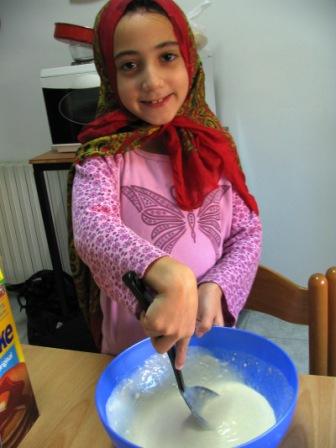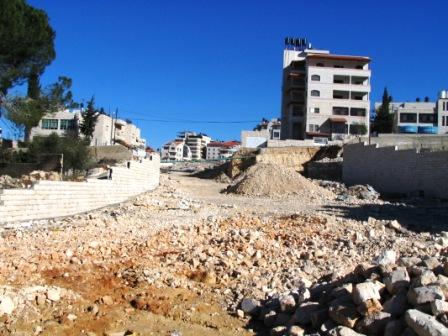 14:
Beit Hanina disappearing 14:
Beit Hanina disappearing
By Skip Schiel
Photos: at home with a family in Beit Hanina and an Israeli road cut thru the community
Beit Hanina is in Jerusalem Municipality , over the 1967 Armistice/Green Line (Occupied East Jerusalem), relentlessly being choked by Israeli developments: the Western bypass road (45) on its west, Wall at its north, which is now erasing the main road to Ramallah plus Road 60, Pisgat Zeev and Neve Yaakov settlements to its east. The choking and transfer of the largest middleclass Palestinian group between Jerusalem / Ramallah is part of Israeli policy to fight demography and grab land, as elsewhere in Jerusalem .
-- Palestine Monitor , November 2004
You could call Beit Hanina a northern suburb of Jerusalem , as Everett is a northern suburb of Boston , but describing it for people in the US presents a daunting challenge. Beit Hanina, a Palestinian community of some 20,000 people, does not exist on some maps, notably those produced in Israel . Why is this? Because it is being swamped by Israeli settlements. The corollary truth is that the settlements do not appear on some maps produced in Palestine .
I had the good fortune last week to reside for four days with a family in Beit Hanina, father Palestinian, mother Jewish from the US , 3 girls of mixed heritage. While with them, I learned at first hand some of the travails of such a community.
One instance: while driving with Nora, she pointed out the intersection at French Hill, which was the site of a suicide bombing last September by an 18 year old Palestinian woman. Two dead, and this would have been an enormously larger number had soldiers not spotted her crossing from the Palestinian side to the Israeli side. At that same intersection--and this is so hard to show I don’t even try--the stop lights are timed to force the Palestinians coming into central Jerusalem to wait much longer than their Israeli counterparts. When I inquired about road rage, Nora informed me that at rush hour this zone is full of trouble.
Another instance: the main road north to Ramallah goes thru Beit Hanina, and then thru a region thick with Israeli communities. I walked this road, observed the elegant homes, the schools, synagogues, and especially the playgrounds in the Jewish settlements. As I watched kids playing, an echo came to me from earlier: in all of East Jerusalem , for Palestinians there are only two playgrounds, and one of these adjoins the notorious Israeli colony of Ras al-Almud, whose construction tore out one wall of the playground’s basketball court.
Another: Beit Hanina is a dicey place to build a home. The town suffers many home demolitions, either because they have been built without the virtually impossible to get permits, or someone in the family is accused of threatening the security of Israel . I visited the sites of two recent demolitions, one with the belongings of the family still scattered on the earth.
A final instance (of many) of the challenges of coexistence is the beginnings of a new road cut thru the center of Beit Hanina. Israel initiated this, destroying roads and homes, to connect two main settler roads (from which Palestinians are barred). It will eventually cut thru play fields and a small forest. I discovered this cut as I wandered one morning along a small road. The road abruptly terminated in a wire fence. Then I saw it: a crude slash thru the community. Later, when I told Nora and Hani about this, they were stunned, had not realized this fact on the ground, and would believe it only when we traveled to it.
For this week’s pair of photos, I show an aspect of the family, struggling valiantly to live in this besieged community, and I add the road cut. What I don’t show is the planned future: Beit Hanina swallowed in the vision of “Greater Israel.”
My reaction? Gratitude to the family for allowing me this brief entrance into their lives, outrage at the project of Greater Israel, and resolve to expose this fact on the ground as widely as possible.
Not to end with disaster in view: I was inspired by an assignment to the Ecumenical Accompanier program to envision a better future for this region (from my good friend and colleague from South Africa , Jeremy Routledge) by imagining two dialogs. First his words:
“The year is 2014 and there has been a settlement of the Israeli/Palestinian conflict that is just, peaceful and environmentally sustainable.
“Without being constrained by how this was achieved, place yourself in this society 10 years from now and write short dialogues between people living in this society as they go about their daily life that give us glimpses of this new society…Introduce them briefly in their imagined contexts, but [don’t include] their history and how they arrived at this point.”
Then mine:
#1. On the train from Ramallah to Jerusalem
Two young men, Cain and Able, are riding on a commuter train between Ramallah and Jerusalem --no checkpoints, no wall, no blockages of any kind.
Cain says, “I remember when I traveled with my parents between Ramallah and al-Quds ( Jerusalem ) when I was growing up. A service taxi from Ramallah to the Kalandia checkpoint, the fear I felt facing the soldiers. I recall one time when my father was turned back, I and my mother were allowed thru, we waited in the rain on the other side for the soldier’s decision. I cried as I waved goodbye to my father.”
“And now,” Able replies, “we ride this train for 20 minutes and we’re at Damascus Gate, far different from the old days when this trip took one to two hours, two taxis, plus the long wait and humiliation at the checkpoint. And of course, many of us without proper papers could not even enter Jerusalem . Now the train drops us off and the al-Aqsa mosque is a five minute walk.”
#2. In the sky above Hebron , having just taken off from the Hebron airport
A family, father Hani (Palestinian), mother Nora (US Jew), daughters Rula and Rivkah, on their way home to Ramallah after visiting Hani’s family in Twani, a small village south of Hebron .
Rula exclaims as she looks out the small plane’s window, “This view is gorgeous. Dad, look there, the Ibrahimi mosque, the line of tourists waiting to get in. I can even see kippahs on some heads, head scarves on most of the women.”
And Rula replies, “Did you notice on the other side, the synagogue side, that old men in kaffiehs and young girls in long dresses (the fashion for Israeli Jewish women) are mixing together on the steps to the synagogue?”
Later, I hope to put up a fuller set of photos from Beit Hanina on my website. Please watch for them.
For a map and explication
Home demolitions in Beit Hanina (2001)
Um Ramzi from Beit Hanina: "We Refuse this Division," Community Voice, PENGON/Anti-Apartheid Wall Campaign, August 8th, 2004--
For the role of the United States in this project, US assistance to Israel, US Embassy, Israel
|



